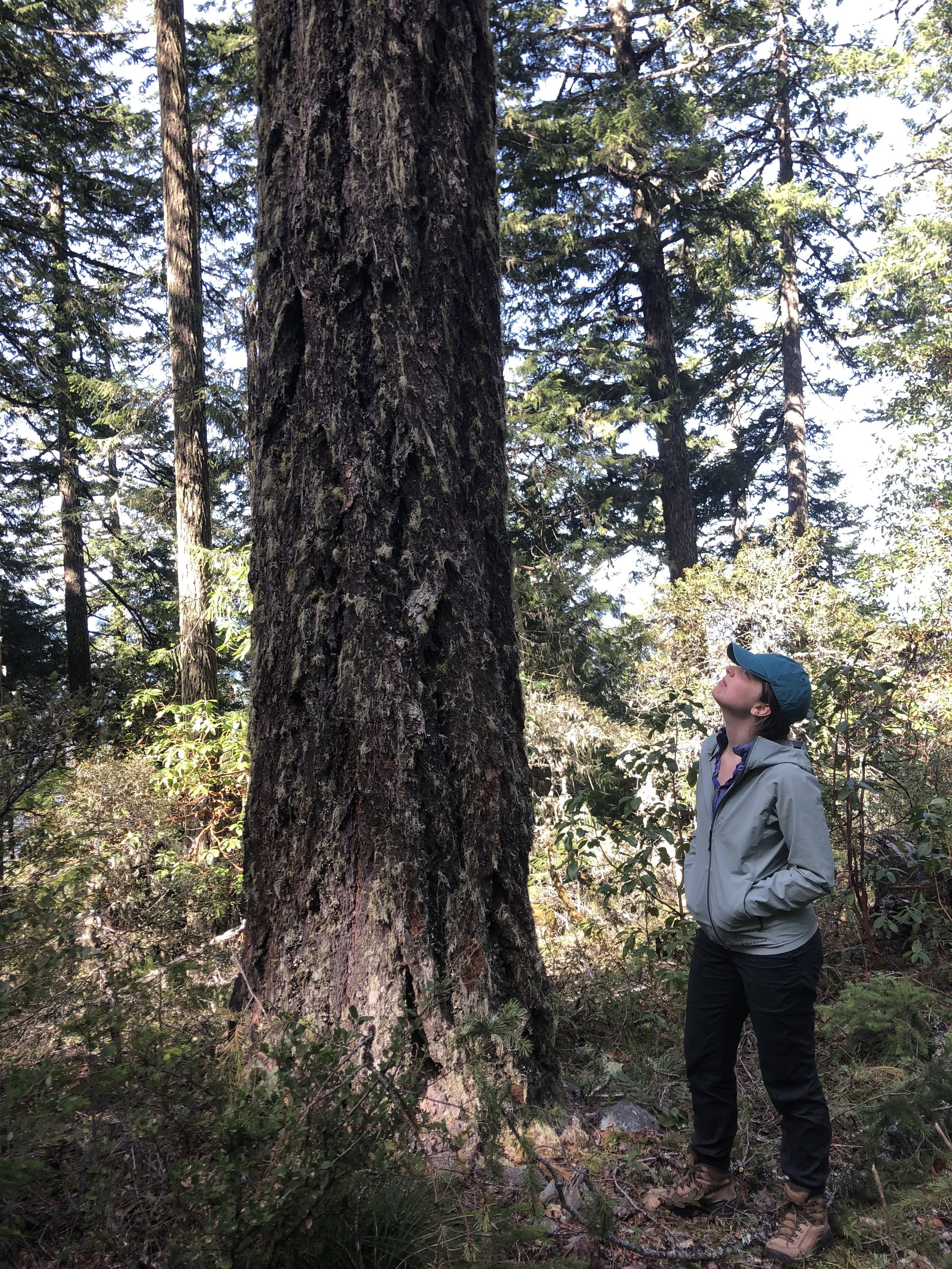Groundtruthing 101 with KS Wild’s ForestWatch Program
Written by Kelsey Furman, December 19th, 2022
Into the Woods
Our ForestWatch Conservation Fellow, Kelsey Furman, stands below a large, mature tree while groundtruthing.
Groundtruthing (aka field checking) is a very important part of the forest defense process that involves getting out in the field and observing the landscape for its true characteristics.
Federal agencies, like the Bureau of Land Management (BLM), develop and manage projects on public lands, and the National Policy Environmental Act (NEPA) requires timber planners to consider all relevant information and involve the public while developing timber sales. For example, project development must include opportunities for the public to provide input and meaningfully engage in the planning process. Whether or not agencies “meaningfully engage” is a different story.
You can see what timber sales the BLM is considering or currently developing on their project planning website: eplanning.blm.gov.
It is important to note, however, that agencies write timber sale planning documents from their point of view. We keep this in mind particularly when reviewing the “need” for the project and the agency’s explanation for it. In addition to the “need,” these planning documents also provide the location of a proposed project and what type of logging the agency intends to conduct. This is the part where groundtruthing comes in—we grab our maps and gear and head out into the forest! Once there, we spend time comparing what the agency has written in their planning analysis documents to what we are actually observing on the ground. Some things we keep an eye out for include:
Proposed new permanent and temporary roads
Big trees and wildlife habitat
Riparian features
The species composition and density of a forest stand
Slope and aspect
Fragile soils
Fuels and vegetation impacts from previous timber sales
During our site visits, we note site-specific information, compare the planning documents to what we see on the ground, and look for inconsistencies or anything that is missing from the planning documents. We will use all of this information when submitting comments, appeals, and legal challenges.
Knowledge is Power
A group of KS Wild hikers and volunteers learn about groundtruthing during a field trip to a proposed logging project.
Groundtruthing is an important part of public land advocacy; relying solely on the agencies’ planning documents will not give you a completely accurate description of the area. When we visit a forest slated for logging, we are able to get a better idea and clearer picture about what the agency is proposing, where it is proposing it, and what’s missing from its analysis. Knowing the landscape’s true characteristics is critical.
It is also important to let the agencies know that the public is involved and paying attention. By getting out in the field, we are more likely to notice when shortcuts are taken or when legally required information is lacking or insufficient.
Ultimately, being an effective forest advocate means knowing what a proposed plan looks like in the field and understanding its likely impacts.
Also, who doesn’t love a reason to get out in the woods?
The Late Mungers Timber Sale
George Sexton, our ForestWatch Director, stands below an old-growth tree that serves as spotted owl habitat in the Late Mungers timber sale project.
The Late Mungers timber sale, part of the BLM’s Integrated Vegetation Management (IVM) project, is a recent example of KS Wild’s groundtruthing efforts. This project area is located west of Williams, OR.
Visits to the project site illustrated just how devastating the proposed timber sale would be for Late Successional Reserves and northern spotted owl habitat. Proposed logging road construction is located in spotted owl nesting, roosting and foraging habitat, logging haul routes parallel stream-side Port Orford cedar stands, and roadside logging targets large fire-resilient trees. In the footprint of the Late Mungers timber sale, existing late-successional forest canopy in the Late Successional Reserve is marked for removal.
Forest Defender Training series
While groundtruthing is a crucial part of engaging with projects on your public lands, these skills aren’t something you’re born with. In 2022, we began implementing our Forest Defender Training Series, a space where our supporters and those with interest can learn how to become more engaged with federal land managers and impact planning and policy. In 2023, our Forest Defender Training Series will incorporate groundtruth training to help educate the public on what it means to get out in the field, monitor logging and public land management projects, and hold federal land managers accountable. During this series we will explain the process in more depth and discuss what we look for when venturing into the forest. Keep an eye on our eNews and social media for the 2023 dates of these trainings. We hope to see you there!



